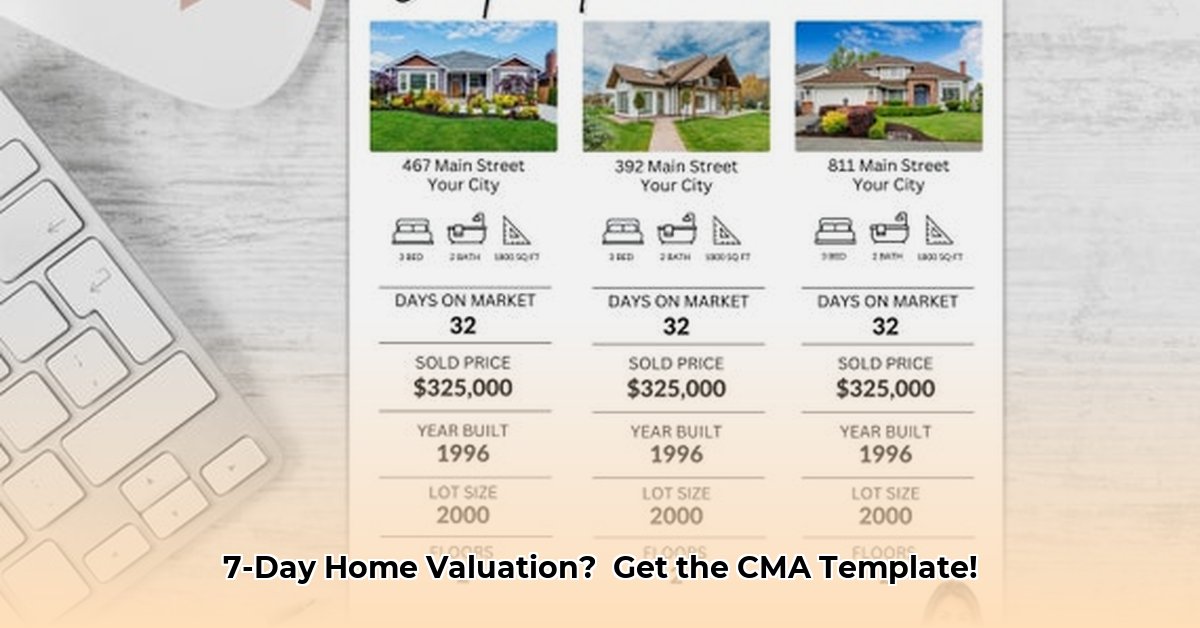
Worried about accurately valuing a home? This guide provides a seven-day plan to master Comparative Market Analyses (CMAs) – your key to confident home pricing. We'll cover the process, from gathering data to managing risk, so you can avoid costly errors and make informed decisions.
Understanding Your CMA Template: More Than Just a Spreadsheet
A CMA template isn't merely a spreadsheet; it's a structured system for gathering, analyzing, and interpreting data to produce accurate home valuations. It ensures consistency and helps you collect the right information. While the template provides structure, your expertise is crucial for interpreting data and creating reliable valuations. It's a powerful blend of technology and human insight.
Your Seven-Day CMA Plan: A Step-by-Step Guide
This plan enables you to confidently value a home within a week. Remember, it's a process, not a race.
Days 1-2: Gathering the Facts
Know Your Subject Property: Thoroughly examine the home. Document details—square footage, bedrooms, bathrooms, special features, property taxes, and HOA fees (if applicable). Take numerous photos to capture details and identify potential issues. This foundational knowledge is critical for comparison.
Identify Comparable Properties ("Comps"): Find at least three recently sold properties (ideally within the last 3-6 months) in the same neighborhood, with similar size, features, and condition as your subject property. Online resources are a great start, but using Multiple Listing Service (MLS) data provides even more precise information. These comps serve as your benchmarks.
Analyze the Competition: Carefully review each comp's sale price, days on market, and unique features. Note differences between the comps and the subject property. This requires your expertise; subtle aspects influencing price must be assessed.
Days 3-4: Number Crunching and Adjustments
Property Condition Assessment: Professionally assess the condition of the subject property against your comps. Identify upgrades (new roof, appliances) increasing value and drawbacks (needed repairs, outdated features) reducing value. Your expertise is pivotal here.
Fine-Tuning the Numbers: Adjust the comparable sale prices to account for differences. Add value for upgrades, deduct for drawbacks. A good CMA template helps maintain consistency in adjustments. It’s not just math; it's informed judgment.
Calculating Your Preliminary Valuation: Calculate a weighted average of your adjusted comp prices for an initial valuation. Weights should reflect your assessment of the subject property's strengths and weaknesses.
Days 5-6: Refining and Reviewing
Market Trend Analysis: Research recent market trends. Are prices rising or falling? How quickly? New construction or infrastructure projects can significantly impact value. Understanding market dynamics is crucial.
Comprehensive Review: Thoroughly review your data, calculations, and conclusions. This minimizes errors. A second opinion can be invaluable here.
Risk Management: Assess potential risks. Which data sources might be less reliable? A risk assessment matrix (see below) provides a visual representation of these risks and mitigation strategies. Don't underestimate the importance of risk mitigation in your CMA.
Day 7: Final Touches
Final Valuation: Present your final valuation, detailing your methodology and supporting evidence. Transparency builds trust.
Presentation: Communicate your findings clearly and concisely, ready to answer questions about your methodology and justify your valuation. A well-presented CMA showcases your expertise.
Risk Assessment Matrix: Identifying Potential Pitfalls
This matrix visualizes potential inaccuracies and suggests mitigation strategies.
| Data Source | Inaccuracy Risk | Misrepresentation Risk | Mitigation Strategy |
|---|---|---|---|
| Online CMA Tools | High | Moderate | Verify with multiple sources and perform expert review. |
| Agent-Collected Data | Moderate | Low | Use standardized data collection and evaluation methods. |
| Public Records (Tax Assessor, etc.) | Low | Low | Cross-check data from multiple public records sources. |
| MLS Data | Moderate | Low | Ensure data is up-to-date and verify information where possible. |
How to Account for Unique Property Features
Accurately pricing a home requires considering unique features missed by online estimators. A CMA allows for meticulous adjustments based on these unique aspects.
Understanding the CMA Process: Beyond Online Estimates
A CMA involves a thorough market analysis, identifying comparable properties and adjusting their sale prices to account for differences from the subject property. This detailed process reflects the nuances of the local market and the unique characteristics of the home.
Identifying Comparable Properties: The Right Comps Matter
The selection of comparable properties is paramount. Features to consider include geographic location, property size, age, condition, and amenities. Proximity to key attractions such as schools and transportation also significantly impacts value.
Adjusting for Unique Features: The Art of the CMA
This stage involves fine-tuning the price of each comparable property, adding or subtracting value based on its differences from the subject property.
| Feature | Adjustment (Example) | Rationale |
|---|---|---|
| Updated Kitchen | +$15,000 | High-end kitchen increases home value significantly. |
| Smaller Lot | -$10,000 | Smaller lots are less desirable in this market. |
| Older HVAC System | -$5,000 | Needs replacement, impacting home value. |
| Pool | +$8,000 | Desirable amenity in this market. |
Finalizing and Presenting the CMA: The Final Product
After adjustments, a refined price range emerges, reflecting the home's unique characteristics and market conditions. The CMA provides an informed estimate, supported by solid data and expert judgment.
Key Takeaways
- CMAs provide far more accurate valuations than online estimators.
- Professional CMAs meticulously adjust for unique property features.
- A systematic approach, focusing on comparable properties and adjustments, is essential for accurate valuations.
- Understanding market fluctuations and local nuances enhances CMA accuracy.
- Utilizing a CMA template streamlines the process and improves efficiency.
This seven-day plan provides a robust framework for creating accurate and reliable CMAs. Remember: your expertise is the most valuable asset in this process.